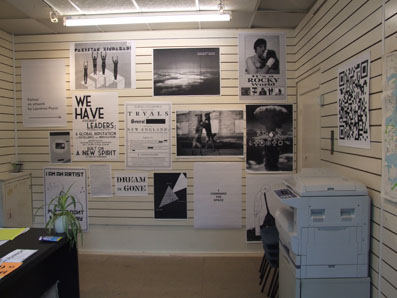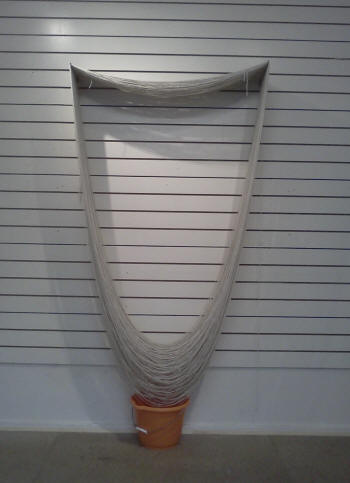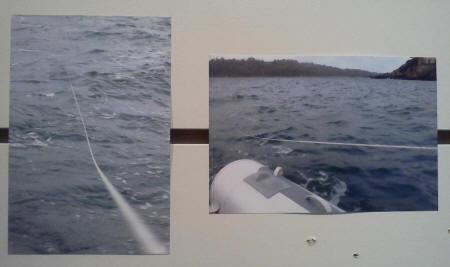|
|
| home | features | exhibitions | interviews | profiles | webprojects | gazetteer | links | archive | forum |
|
Beyond the closed shop Gabrielle Hoad explains how Plymouth’s Project Space 11 suggests a positive way forward for artist-led activity in Devon
The closed-off space suggests something private and furtive. While it’s a fitting setting for a show that investigates the gaze, it sits in marked contrast to the wider spirit of the enterprise that created it. Unlike many small-scale artist-led projects in Devon, which are run by artists largely for their own benefit, Project Space 11 is a venture with a strong drive towards collaboration and networking. ”We’re thinking of what sort of networks we can build with other artist-led spaces in the UK and then feeding that back into the arts ecology of Plymouth,“ says one of the founders, Beth Emily Richards. [1] She has been programming this tiny, temporary venue along with four other Plymouth-based artists – Ben Langworthy, Bryony Gillard, Lucy Brennan and Scott Daniels – since June 2010. Project Space 11 not only showcases the imagination and energy of its participants, but also offers a case study in enlightened artist support – by artists for artists. Using the project as an example, this article looks at the situation of artist-led exhibiting projects in Devon and highlights the benefits of a more outward-looking approach.
Made in Devon – the context Thanks to the South West’s strong reputation for craft, being a ‘local artist’ has become synonymous with being a maker of saleable work or a possessor of transferable skills such as painting, pottery or printing. There’s no shortage of events such as open studios and craft fairs – many of them organised by artists – which offer commercial outlets for work.
Artist-led ventures in Devon come and go, but few seem to make an impact. As a result, it has fallen largely to established organisations such as Spacex, Plymouth Arts Centre, CCANW and Exeter Phoenix to fly the flag for cutting edge contemporary art in Devon. But, by their very nature, such organisations can rarely provide the kind of opportunities artists offer to their peers. There are exceptions. Aune Head Arts (AHA) is a rurally based contemporary arts organisation, which was founded in 1997 by two practising artists Richard Povall and Nancy Sinclair. The organisation remains strongly supportive of grassroots artistic activity by providing opportunities for local and regional as well as national artists. Notable past projects include Triparks and Women in Farming. Successful artist-led projects can also be formed around temporary alliances or one-off events. PL:ay was a one-day festival produced jointly by LOW PROFILE and one.c, which presented live art, video, photography and installation in Plymouth in 2007.
Project Space 11: the evolution Whether by accident or design, a number of initiatives arrived that seemed set on addressing the gap. In 2006, Spacex in Exeter began the X-Panel, an initiative to connect with 16-25 year-olds in the region by inviting them to curate part of the gallery’s programme. And, at the end of 2009, artists Steven Paige and Sovay Berriman worked with Plymouth Arts Centre on Control Point: A Temporary Facility. This unusual initiative hired 17 early-career artists and involved them in a six-week professional practice programme, complete with studio space, lectures and national networking and residency opportunities. While exposing the mechanics of artistic survival to the gallery audience, Control Point also provided participants with lessons that might otherwise have taken years to learn through trial and error.
At the same time, Kath Davies, Principal Arts Officer for Plymouth City Council and Hannah Jones, Curator of The Gallery at Plymouth College of Art began talking to local artists about stewardship of an empty unit in Plymouth City Market. The unit had been funded for a year by Arts Council England and was supported by the Plymouth City Centre Company as part of the council’s planned regeneration of the West End of the city. As artists themselves, Davies and Jones understand what artists need from backers. Having handed over the space and given the artists room to innovate, they have continued to offer vital support and advice on tap. Mentoring from curators Paula Orrell and Caroline Mawdsley, and others at Plymouth Arts Centre has also been available. Time and energy that many groups expend on fund-raising and venue sourcing could instead be devoted to elements such as programming and marketing. The group has been able to plan ahead and to approach established artists with confidence. “For artist-led groups, the whole system of applying for funding feels so lengthy and traumatic that people often try to fund things themselves,” says Scott Daniels of Project Space 11. “You go from show to show with what you can afford. There’s no backing for any continuity.” Having a year’s budget in the bank has given the group a momentum often lacking in comparable projects.
Project Space 11: the results
They went on to show AgitProp!, a series of 27 artist’s propaganda posters sited across the West End of the city, with the project space acting as the temporary campaign office. Dean Knight’s Modern Sculpture was a witty reflection on sculpture of the mid-to-late 20th century, which also brought the space itself into play as an integral part of the experience. Peepshow was the fourth, and included video work by Hayley Newman, Lucy Gunning and Abigail Reynolds. A fifth show, Perimeter by Jonty Lees, runs through November, and the programme continues until at least April 2011. The quality of the work, the presentation, the programming and the interpretation far exceed the standards most artists set for themselves when working in such spaces. Deftly side-stepping the recessionary cliché of art in disused shops, the project hasn’t simply parachuted work into a convenient empty space. Instead the team has worked with artists to generate work that is, at least in part, site specific. Beth Emily Richards explains: “It made absolutely no sense to polish [the space] up. Rather than thinking about the size [and condition] of the space as an obstacle, we’re thinking about it as a challenge in our programming.” As a result, all exhibitions have sat comfortably in the market context, naturally provoking engagement, connection and conversation between artists, traders and market users. There has been a healthy two-way exchange of art and trade as visitors arriving to see the art spend money in the market and surrounding independent shops. “Being mindful of the social context is really important,” says Richards. It’s about demystifying or “normalising” art, adds Daniels, rather than converting people. Project Space 11 has addressed the concept of ‘local artist’ head on by drawing artists from the South West whose work would not be out of place in the international sphere. They have created a space in which early-career artists (such as Dean Knight) exhibit on the same footing as those with burgeoning international reputations (for example, Jonty Lees and Melanie Jackson). The notable exceptions from the Project Space 11 programme are the programmers themselves. Continuing to describe themselves as artists not curators, all five have ambitions for their own careers, but were clear early on that this would not be a self-referential exercise. Although they have exploited personal connections to source artists, the group strives to open up networks too. The most ambitious element of this is a plan to collaborate with artist-led groups in other cities taking part (alongside Plymouth) in the British Art Show (2010-11).
The benefits of connection
As artists compete for scarcer resources, there’s a temptation to feel that it’s ‘every man for himself’. Yet, to have any meaningful sustainability, artist-led projects need a purpose over and above the promotion of the group members’ own careers. Steven Paige warns artists against “slipping into becoming a self-serving clique” while Chris Brown of Cardiff-based G38 warns that ”it’s difficult to develop your career … without skewing the organisation.” (speaking to Tethervision in 2010) [4] . I believe that artists will be more dependent on each other than ever before. Perhaps there is more to gain by looking outwards than by pulling down the shutters? As a Devon artist myself, I’d like to propose that we get past the rather insular approach that has characterised many artist-led ventures to date. We must extend our networks, trust and nurture each other, and keep goodwill in circulation. Project Space 11 was the result of more experienced artists (Berriman and Paige, Davies and Jones) sharing both knowledge and opportunities in powerfully enabling ways. Control Point helped to equip the group with many of the skills and contacts they needed (as well as a safe environment in which to hammer out their shared aspirations). Meanwhile, the support of Plymouth College of Art and Plymouth City Council gives them the practical means to achieve something worthwhile at a critical career stage. The ripples continue to spread outwards as the Project Space 11 team invest their own ideas, effort and experience and invite other artists to work with them.
It’s also about developing skills. The insight and connections won by a spell as a curator or a project manager more than make up for the time lost for creative practice. Critical engagement is likely to be heightened too. As the Project Space 11 team told ArtsCulture: “Working with artists whose work we admire … encourages you to raise the bar for your own work… There may be less time for making or reflecting on our own work now, but when we do, we approach it more rigorously.”[7] The evolution of Project Space 11 may have involved a chain of happy coincidences (along with much hard work and many good decisions), but there’s no reason why it can’t now be intentionally repeated. Artists working together have the potential to build a creative economy where ideas, resources and audiences can be jointly nurtured. Talk of a visual arts ecology is becoming something of a cliché, but the cliché is apt. We are interdependent.
5/11/10 www.gabriellehoad.co.uk www.e-leven.co.uk
REFERENCES [1] Hoad, G. (2010) Interview with Scott Daniels and Beth Emily Richards of Project Space 11, Plymouth City Market, 7 October [2] Dalton, G. (undated) ‘The Future of Artist-Led Activity’ Alias http://www.aliasarts.org/GordonDalton.htm [3] Paige, S. (2009) ‘Wanna be in my Gang? When artist-led can become art mis-read’ Alias http://www.aliasarts.org/artistledrisk.htm [4] Tethervision (2010) Interview with Chris Brown of G39 Cardiff http://tether.org.uk/tv/ [5] Hyde, L. (2006) The Gift: How the Creative Spirit Transforms the World, Edinburgh: Canongate [6] ‘Pay It Forward’ (2010) Wikipedia http://en.wikipedia.org/wiki/Pay_it_forward [7] ‘Project Space 11 in Plymouth market set to demystify and promote contemporary arts’ (2010) ArtsCulture http://artsculture.newsandmediarepublic.org/2010/06/16/projectspace11-in-plymouth-market-set-to-demystify-and-promote-contemporary-arts/
FURTHER READING Art Swap Europe (2010) http://igbk.de/dateien/dokumente/de/art_swap_europe_-_catalogue.pdf Billing, J, Lind, M and Nilsson L., (2007) Taking the Matter Into Common Hands, London: Black Dog Publishing
|
|
|

 As
its title suggested, the venture could have been no more than an
interlude or experiment, but four participants (along with an intern
from the arts centre), decided to continue their association and began
to shape ideas for an artist-led space.
As
its title suggested, the venture could have been no more than an
interlude or experiment, but four participants (along with an intern
from the arts centre), decided to continue their association and began
to shape ideas for an artist-led space.
